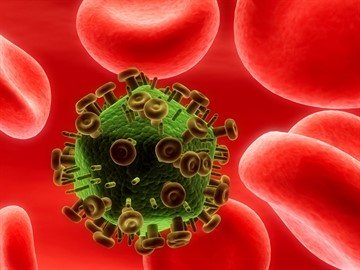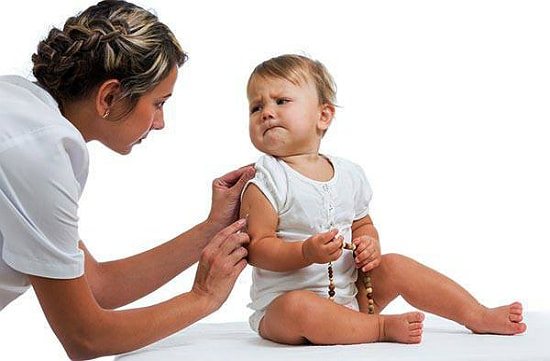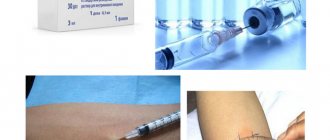How long does the BCG vaccine take to heal?
It is possible to notice the body's reaction to the administered vaccine only after a few weeks. The vaccination reaction can last more than 4-5 months . If a pustule with suppuration appears at the injection site, do not panic - this reaction is within normal limits.
Over the course of several more months, the vaccination site will undergo changes. How long does the BCG vaccination take to heal? It will take about a year for a scar to appear, indicating a correctly administered vaccination and developed immunity, but the duration of the process may vary for different children. It all depends on the individual characteristics of the body and other factors.
If there was a trace but disappeared
There are cases when a scar formed after BCG, but then it disappeared.
This mainly happens after the vaccine expires, that is, after 7 years. Sometimes there is no trace of the BCG vaccination after a couple of years. This indicates that the vaccine has completed its effect earlier than expected. In this case, it is recommended to revaccinate the child.
It should be remembered that before repeating the vaccination, it is also important to perform a Mantoux test and correctly evaluate its result. If the Mantoux reaction does not appear, that is, no redness appears at the injection site, then the test is regarded as negative. If there is no trace after BCG vaccination, it is advisable to revaccinate.
The healing process is normal: in the first weeks and thereafter
If the drug is administered correctly and there are no contraindications at the time of vaccination, the healing period should proceed without complications. How does BCG heal? The whole process looks like this:
- After administration of the drug, a papule forms at the injection site. Its color can vary from white to red-violet. Adjacent areas of skin on the arm should remain normal color. A rise in body temperature after vaccination is also considered normal.
- After about 30-45 days, the injection site begins to turn red.
- Next, a blister appears, filled with liquid and purulent contents, resembling an inflamed pimple.
- Pus begins to flow out of the wound and forms again.
It is strictly forbidden to scratch a purulent ulcer, squeeze out pus, or treat with antiseptic ointments.
- The peak of suppuration is followed by the formation of a crust. It cannot be disturbed or disrupted.
- After a few months, the healing process ends and a small scar forms at the vaccination site, which indicates that the vaccination was effectively carried out.
The duration of the healing process directly affects the degree of acquired immunity. The more time has passed from the moment of vaccination to the formation of a scar, the stronger the immunity. This is also evidenced by the size of the scar.
The baby's temperature has risen: is it normal or a complication?

This can be a normal or pathological reaction. Slight hyperthermia (37-38 degrees) is a natural symptom. The temperature rises in response to the introduction of antigenic material, indicating the beginning of the formation of specific immunity.
Hyperthermia usually occurs on the first day after a BCG injection. The temperature can remain high for 2 to 4 days. The condition normalizes on its own. But there are children who react sharply to rising thermometer readings.
They may experience seizures. In this case, antipyretic medications are used. If hyperthermia is observed for a longer period (more than four days), then this may indicate the development of a pathological process.
The following complications are possible after BCG:

- infection . Bacteria entering the wound can cause severe inflammation and an abscess. In this case, the baby will have a fever, the injection site will become red and swollen;
- development of an infectious viral disease . After vaccination, the child’s immunity weakens. Therefore, the baby becomes susceptible to infection with various viruses and infections. In addition to the high temperature, the baby develops a runny nose, pain and redness in the throat;
- allergy. Occurs with high sensitivity to tuberculin. An allergic reaction is manifested by rashes and itchy skin. In severe cases, anaphylactic shock may develop. In this case, loss of consciousness and respiratory dysfunction are observed;
- development of tuberculosis . In children with weak immunity, the body may not cope with the vaccine. In this case, vaccine-associated pathology develops;
- exacerbation of a chronic disease . BCG weakens the immune system. This can lead to exacerbation of chronic pathologies of internal organs. In this case, the temperature also rises.
Photos of healing by month
It is important for mothers to know what the vaccination site should normally look like some time after vaccination. Photos by month will help you figure this out and not panic prematurely. In about a month you will see this picture:

The color may also be lighter or darker.
After two months, the picture changes and with the appearance of an abscess, many mothers fall into panic. But this reaction is quite normal and correct.

As it heals, the scab will fall off and the healing process will end with the formation of a scar.

The duration of each stage may differ slightly for different children, but the sequence is always maintained.
Side effects and consequences
As a rule, BCG vaccination is tolerated normally. But some newborns develop side effects and severe complications. Bad consequences are caused by improper preparation of the baby for vaccination and violation of asepsis by doctors.
The quality and storage conditions of the antigenic material are also of great importance. Local complications are usually registered in the first six months after immunoprophylaxis.

Adverse reactions from BCG:
- cold abscess;
- lymphadenitis;
- extensive ulcers at the injection site;
- keloid scar;
- osteitis;
- inflammation of the lymph nodes;
- granuloma annulare.
To minimize the likelihood of complications, you should refuse to vaccinate a child who has the following problems:
- chronic pathologies in the acute stage;
- the presence of an infectious viral disease;
- prematurity (weight less than 2.5 kg at birth);
- immune disorders (HIV infection, AIDS, psoriasis);
- high body temperature;
- presence of complications after BCG in close relatives.
Most often, side effects of BCG are local in nature. They occur in 0.06% of all vaccinated people.
Possible deviations and complications in healing
Vaccination against tuberculosis can be carried out in violation of the drug administration technique, which leads to deviations in the healing process. For example, if too much purulent fluid is produced, it may be suspected that the nurse administered the vaccine subcutaneously rather than intradermally.
The absence of suppuration can also be considered a deviation from the norm. This means that the vaccine is injected too deep into the layers of the skin and an abscess is formed there. This condition is more dangerous because it can provoke the development of an abscess.
Most children tolerate the vaccine normally and end up with the formation of stable immunity against tuberculosis, but complications also occur. They are most often characteristic of children who have a congenital decrease in immunity, for example, if the mother is HIV-infected.
Possible complications include the following:
- Abscess formation when the vaccine is administered too deeply. In such situations, surgical intervention is required.
- Formation of a large ulcer at the injection site. This indicates an increased sensitivity of the body to the components of the drug. Local therapy will be required.
- When mycobacteria spread to the lymph nodes, an inflammatory process develops in them. If there is an increase of more than a centimeter, then surgical treatment is required.
- At the site of vaccination, it is not a scar that forms, but a keloid scar. In such situations, repeated vaccination at 7 years of age is not given.
- In case of severe immune disorders, a generalized BCG infection develops in the child’s body.
- After 1-2 years, there is a danger of developing bone tuberculosis with a weak immune system.
Sometimes scar formation does not occur after vaccination. This may indicate that immunity has not been formed or the vaccine was administered incorrectly.
Sometimes the absence of a scar is associated with innate immunity against tuberculosis.
In such situations, Mantoux is given; if a negative result is obtained, the vaccination is repeated.
Types of vaccination

This vaccine has been developed in two variations: the introduction of the BCG vaccine and BCG-M, which, compared to the first, is considered a gentle vaccination option. As a rule, this simplified type of vaccination is administered to premature children whose body weight is more than 2 kg, as well as to children who, at medical discretion, have not undergone this vaccination in the perinatal center, but after a second medical examination.
The organization of the BCG-M vaccine is recommended in places where the epidemiological situation for tuberculosis is considered positive. Therefore, experts do not recommend vaccinating a child on your own unless it is carried out by a medical professional who knows the BCG algorithm.
What to do if BCG does not heal?
The healing process is long and the duration may vary for each baby. Some mothers panic if after three months a festering wound remains, there is redness and the baby periodically has a fever.
The whole process can take up to one year, and if the BCG does not heal after a long time, then you should see a doctor. In some babies, suppuration may end with the formation of a crust, and then begin again with renewed vigor. Most often this is within the normal range and no intervention is required. Sometimes the cause of this condition is infection getting into the wound and scratching it. To avoid this, you can cover the injection site with a napkin.
Mommies should worry if more than six months have passed, and the completion of the scarring process is not even visible. The vaccination site looks very inflamed, there is an extensive abscess. In such situations, you should not do anything on your own; it is better to visit a pediatrician who will find out the reasons for the long healing process and tell you what to do.
Now mothers themselves have the right to decide whether to vaccinate their baby or not. But we must always remember that by refusing vaccination, the child’s health is at great risk. It is better to experience some inconvenience after vaccination than to then deal with long and difficult treatment for tuberculosis.
The need for BCG vaccination
Every healthy person who follows the general rules of a healthy lifestyle has their own innate immunity against tuberculosis. Therefore, even a small dose of dangerous bacteria will not lead to the development of such a disease in the body. But for your own reinsurance, it is also important to have acquired immunity, which is acquired as a result of BCG vaccination.
The live mycobacteria contained in the vaccine, related to the BCG-1 strain, spread throughout the body after BCG vaccination, resulting in long-term human immunity.
The main purpose of such vaccination is to prevent tuberculosis. In the Russian Federation, all doctors adhere to such vaccination and administer BCG to children only three times in their life:
- on the third day of the child’s life;
- at the age of seven, revaccination 1;
- at the age of fourteen revaccination 2.
BCG vaccination should be carried out intradermally, the total dosage of which will be 0.05 mg. in a volume of 0.1 ml, and BCG vaccination is 0.025 mg. in the same volume. To avoid adverse consequences, it is important that such a procedure is carried out only by a specialist. In the area of the forearm, the baby’s skin is lifted with a syringe needle, then a drug is injected, including elements of Calmette and Guerin, while the generally accepted BCG vaccination technique is followed.
In the maternity hospital, the BCG technique is performed on days 3-7 after birth, with an advance examination by a pediatrician and, as a rule, in the morning. After the BCG vaccination, no other drugs should be administered for a month. After the child has been vaccinated with the BCG vaccine, it is necessary to indicate in the history all the information about the administered drug, and also enter the same information into the child’s exchange card after discharge.
Before administering the drug, the medical worker performing the vaccination must study the drug passport in detail. A child who was not vaccinated during the first seven days of life due to illness. Over the next six months after recovery, he will one way or another receive the BCG-M vaccination.
If vaccination is carried out on the day the newborn is discharged, then at least one hour must pass after vaccination is completed, during which doctors look for the manifestation of any reactions. If such reactions are detected, discharge will have to be delayed. In situations where rapid discharge of the baby from the perinatal center is necessary, the child is vaccinated with BCG-M on the third day after birth. Only vaccinated healthy children are already being discharged home.
Normal healing
To avoid unfounded concern, as well as to take the necessary measures in a timely manner if deviations occur, you need to understand which post-vaccination reactions are normal. The healing process lasts on average up to 5 months and takes place in several stages.
- The formation of a whitish tubercle 5-10 mm in size, which appears immediately after grafting and completely disappears within 20 minutes. There may be slight redness with a bluish tint in the injection area. The swelling, which can last about three days, should not cause alarm.
- The formation of a papule filled with light yellow, and in some cases red, liquid. The appearance of an abscess in newborns occurs at 6-8 weeks, in those who are vaccinated again - after a week, which is the body’s immune response. The lack of such education is also a variant of the norm.
- After 3-4 months, the abscess dries out, sometimes bursts with the release of its contents, and then becomes covered with a scab. The crust may fall off several times, but then form again.
- The appearance of a reddish spot and a scar of 2-10 mm.
Healing is often accompanied by itching, sometimes a feeling of movement in the papule, but pressure and intense rubbing of the injection site should be avoided.
The process of maturation of the abscess should not be accompanied by pain, extensive hyperemia and swelling of more than 2.5 cm, or extension to the shoulder with a significant increase in temperature. The occurrence of such symptoms is a direct indication for seeking medical help.
The formation of immunity takes about two months. At this time, the baby is susceptible to infection, just like an unvaccinated one.
In 5-10% of children, primary vaccination does not result in the appearance of a visible trace of the injection, which indicates an insufficiently developed immunity to tuberculosis infection. In this case, a Mantoux test is performed, and if the result is negative, re-immunization is performed.
Contraindications to the introduction of BCG into the child’s body
BCG is a fairly serious vaccination that has a number of contraindications, which the doctor should inform parents about immediately before administering the vaccine. What are these contraindications you will see below:
- if the patient has any intrauterine infections or purulent damage to the body;
- the child is slightly premature and weighs less than 2.5 kilograms;
- the child has mental health problems and various neurological abnormalities;
- for ARVI or other viral diseases;
- if any family members already have tuberculosis.
These were contraindications for the initial administration of vaccination, however, there are cases when the procedure may need to be repeated. And this time there are also a number of contraindications, namely:
- the presence of cancer or damage to cells of the circulatory system;
- the child has an acute respiratory viral infection or a non-infectious disease;
- the presence of allergic reactions that can cause significant harm to health;
- if a child has been given mantu and the result is either positive or not clear to doctors, then it is better to refuse repeated vaccination;
- Before this, the child had an unusual reaction to BCG, then it is better for him not to get this vaccination again;
- if the patient is undergoing radiation therapy.











